Art and Statuary in the Grand Staircase Landings
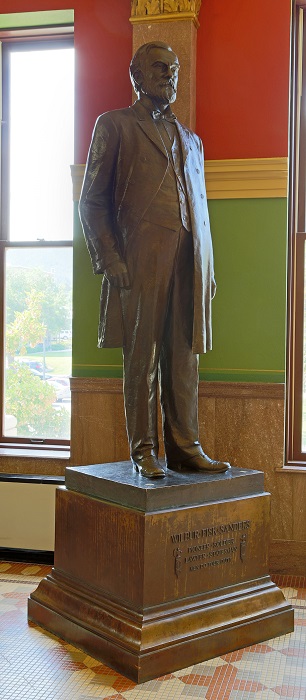
Sigvald Asbjornsen, bronze, 1913. 131" x 71" x 68",
cast by the Henry-Bonnard Bronze Company, Mount Vernon, New York
(Photo courtesy Tom Ferris for MHS)
Wilbur Fisk Sanders (1834–1905) arrived in Bannack, Idaho Territory, in 1863, and is best remembered as one of Montana’s first prosecuting attorneys and one of the organizers of the Vigilantes. In addition to helping found the Montana Historical Society in 1865, Sanders also was voted by Montana’s state legislature to be one of Montana’s first senators. In 1911, the state legislature appropriated five thousand dollars to erect his statue; Montana senator and copper baron William A. Clark provided free casting of the sculpture. Sigvald Asbjornsen (1867–1954) was a Norwegian-born Chicago artist. During his career, which spanned six decades in the United States, he completed numerous public commissions including busts and statues of such notable figures as Benjamin Franklin, President Grover Cleveland, and eleventh-century Icelandic explorer Leif Erikson.
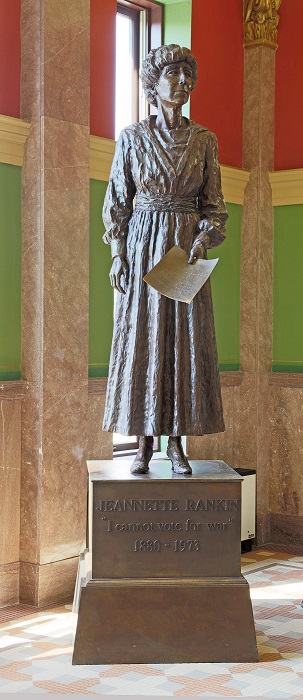
Terri Mimnaugh, bronze, 1980, 100" x 29" x 29",
cast by Frontier Bronze, Great Falls
(Photo courtesy Tom Ferris for MHS)
A prominent advocate of women’s suffrage, Jeannette Rankin (1880–1973) became the first woman to serve in the United States Congress after Treasure State voters elected her to the U.S. House of Representatives in 1916. In her first term (1916–1918), she was one of only fifty-six legislators to vote against the United States’ entry into World War I. In her second term (1940–1942), she cast the lone dissenting vote against the United States’ entrance into World War II. This statue was the first major piece by Montana artist Terri Mimnaugh (b. 1955), and it was dedicated in 1980. An identical statue resides in National Statuary Hall Collection in Washington, D.C., where Rankin serves as one of Montana’s two honorees (Charles M. Russell is the other).
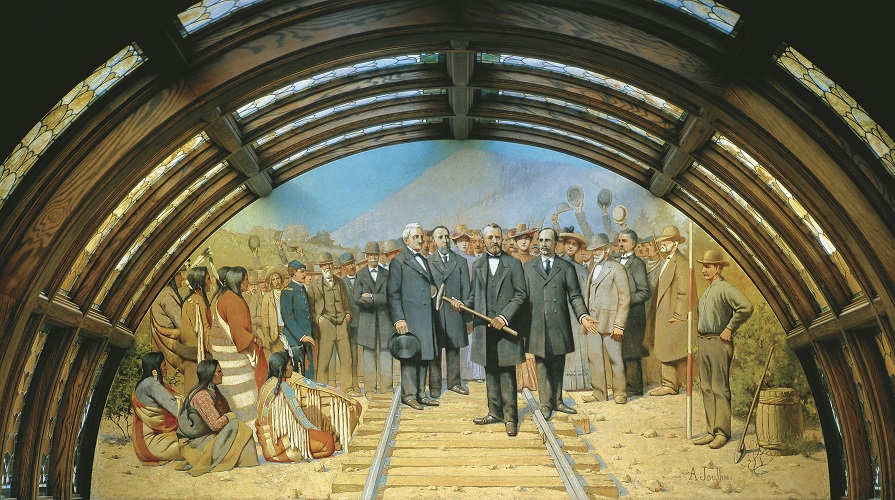
Amédée Joullin, oil on canvas, 1903, 183" x 90"
(Photo by Don Beatty)
Driving the Golden Spike is the only mural in the Capitol that was not commissioned by the State. Rather, it was given to the people of Montana by the Northern Pacific Railroad. The painting commemorates the completion of that company’s transcontinental line on September 8, 1883, at Gold Creek (approximately half way between Helena and Missoula). Former president Ulysses S. Grant wields the sledgehammer that he will use to drive the spike while Northern Pacific president Henry Villard looks on from the right. The bearded gentleman behind Grant to the left is Secretary of the Interior Henry Moore Teller. Secretary of State William M. Evarts, the event’s main speaker, stands just in front of Teller. At the lower left can be seen a delegation of Crow Indians—dressed in ceremonial finery—whose land the railroad crossed. Missing from the image is any representation of the Chinese workers who helped lay the tracks. Amédée Joullin (1862–1917) was a San Francisco–born painter who studied art in California and Paris. He is best known for paintings of California scenes and Native American subjects.
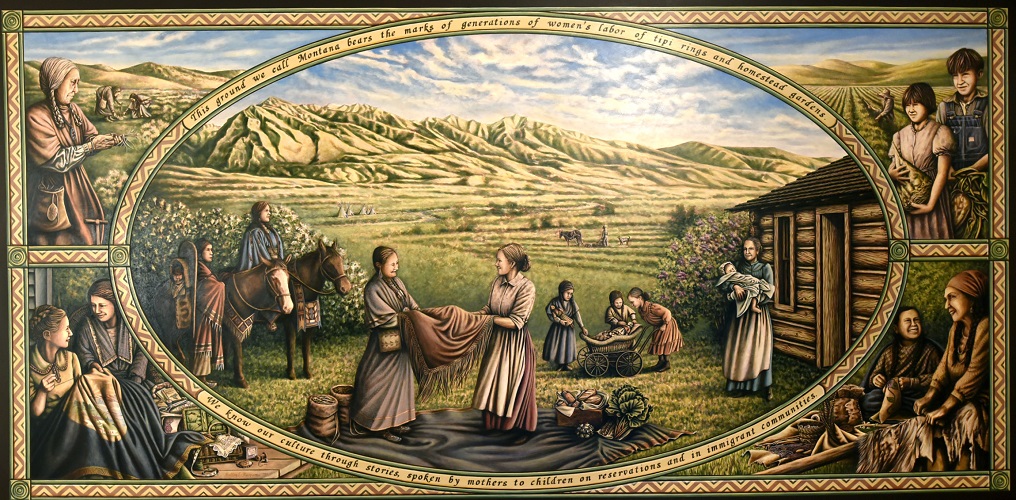
Hadley Ferguson, oil on panel, 2015, 60" x 120"
(Photo by Tom Bauer/Missoulian)
Set in the late nineteenth century, the central scene depicts Native American and homestead women trading goods. The four vignettes surrounding the central image bridge the divide between the nineteenth and twentieth centuries and depict women digging bitterroot, historically an important food source for several tribes and, since 1895, Montana’s state flower; two women stitching a state flag representing the mixing of domestic arts and formal politics; children harvesting beets, representing the Mexican-American families who contributed to the economy and community of eastern Montana; and an Indian mother and daughter beading and preparing a hide, illustrating the teaching and learning of traditional arts across generations. Women Build Montana: Culture is half of a two-part mural that was authorized by the 2011 legislature to honor the history of Montana women as community builders. The two panels were executed by Missoula artist Hadley Ferguson (b. 1976) and installed in 2015.
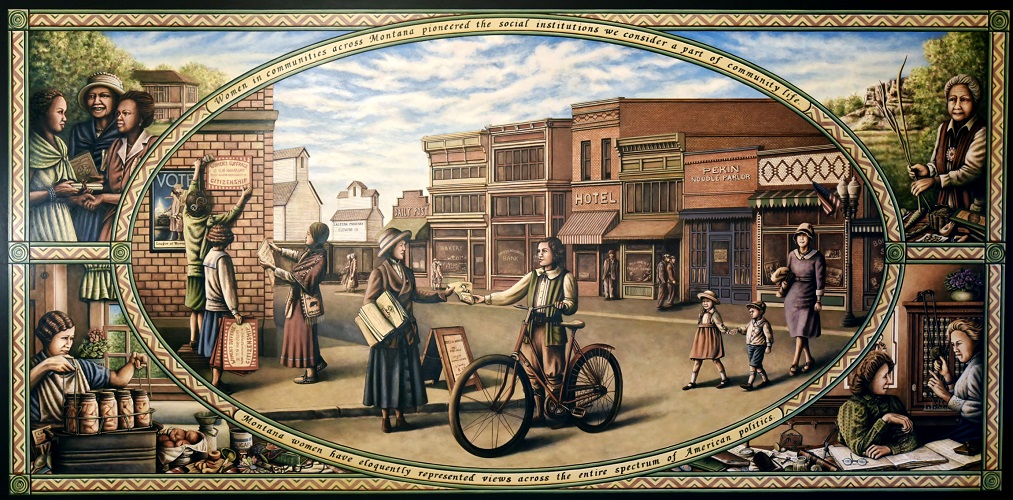
Hadley Ferguson, oil on panel, 2015, 60" x 120"
(Photo by Tom Bauer/Missoulian)
The central scene is set in the fall of 1924 in an eastern Montana town. It marks the tenth anniversary of Montana women’s suffrage and acknowledges the year in which Native Americans—men and women—gained the right to vote with the passage of the Indian Citizenship Act. The four vignettes surrounding the central image depict members of the Montana Federation of Colored Women’s Clubs handing out a scholarship, representing the many volunteer associations that supported women’s education; a woman canning fruit, which references not only the work of homemakers but also the important role of home extension agents; telephone operators, who personify clerical workers and women as labor union members; and an Indian woman teaching botany, illustrating Native women’s knowledge of the medicinal and nutritional use of Montana plants. Women Build Montana: Community is half of a two-part mural that was authorized by the 2011 legislature to honor the history of Montana women as community builders. The two panels were executed by Missoula artist Hadley Ferguson (b. 1976) and installed in 2015.
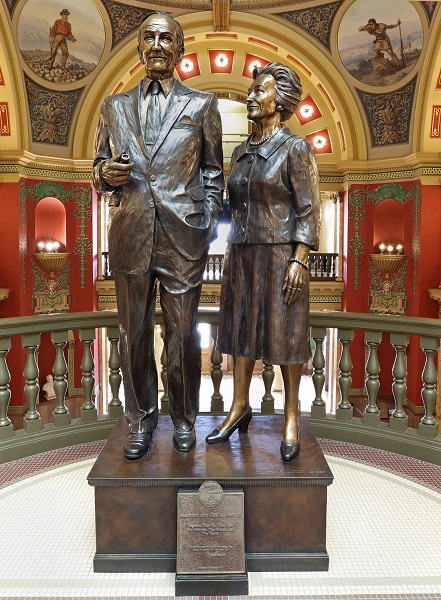
Gareth Curtiss, bronze, 2001, 102" x 42" x 30"
(Photo courtesy Tom Ferris for MHS)
Mike Mansfield served Montana and the United States in many capacities—United States Representative (1942–1952), United States Senator (1952–1977), and United States Ambassador to Japan (1977–1989). The longest-tenured Senate Majority Leader, serving from 1961 to 1977, Mansfield shepherded the Civil Rights and Voting Rights Acts as well as many Great Society programs through the Senate. After a bipartisan group of Montanans raised eighty thousand dollars for a monument to Mansfield in 1999, he refused to accept the honor unless Maureen, his wife, was recognized for the role she played in his success. Fortine native Gareth Curtiss (b. 1959) was chosen through a national competition to create the monument.
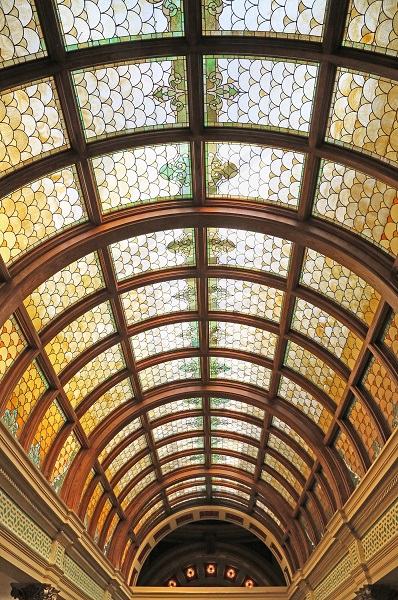
Art Glass Barrel Vault
(Photo courtesy Tom Ferris for MHS)
Although it was a highly touted feature of the original building, the art glass barrel vault was removed in the 1960s to make room for additional office space. Charles and Sue Bovey of Great Falls purchased the barrel vault, and carefully dismantled it, storing it on a train car in the Bovey’s historically recreated village of Nevada City. When the Montana legislature purchased Nevada City along with the Bovey’s historic properties in nearby Virginia City in 1997, the state once again assumed ownership of the art glass pieces. In 1999–2000, the barrel vault was reinstalled in its original home over the Grand Stairway as part of a building-wide restoration project.
